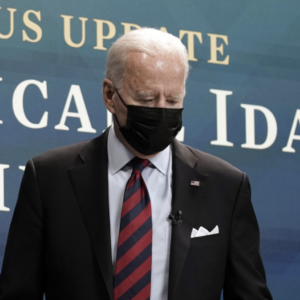Michael Graham comments on President Biden’s statements of climate alarm.
“We’ve got to listen to the scientists and the economists and the national security experts. They all tell us this is code red,” President Joe Biden said while visiting neighborhoods in New York and New Jersey hit hard by Hurricane Ida.
“The nation and the world are in peril. That’s not hyperbole. That is a fact,” he added.

But is it? While the president is well known for his empathy, his climate science is a bit weak. Almost everything he said was factually incorrect.
Biden’s not alone. Media coverage of Hurricane Ida — as with every other major weather event — was full of reports that the latest storm or flood or fire is “proof” that a climate disaster is impending. Not claims average temperatures are rising — a conclusion nearly all climate scientists concede –but that the weather is getting worse and a world-killing climate crisis is right around the corner.
As Rep. Alexandria Ocasio-Cortez put it in the wake of Hurricane Ida, “The fossil fuel industry and humanity are incompatible …there is no sustainable future where fossil fuels continue to be burned.”
“Not a political opinion,” she added. “That’s just science.”
In scientific circles, this is called “an unsupported hypothesis.” Average Americans would call it, well, “fertilizer” is close.
“Contrary to common knowledge, the frequency of hurricanes hitting the Continental US has not increased over the period 1900-2020,” climate expert Bjorn Lomborg told InsideSources. “The frequency of the much more damaging major hurricanes (category 3+) is not increasing, either.”
When the president says “These disasters aren’t going to stop. They’re only going to come with more frequency and ferocity,” it’s frightening. But it’s not factual.
Many media reports have focused on the financial costs of hurricanes, storms, and floods, arguing they’re doing more damage today than in the past. This is also untrue, based on the numbers.
Despite the fact that far more people are wealthy enough to live along the world’s coastlines in beachfront homes and condos than a century ago, the comparative costs of weather events have declined.
“Today, hurricanes around the world cause damage worth 0.04 percent of global gross domestic product,” Lomborg noted. “And the destruction dealt by these storms is projected by a study in Nature to drop to 0.02 percent of global GDP in 2100 as the world economy gets richer, making infrastructure more resilient.”
And the news regarding the human toll of weather events in this “code red” moment is even better.
“Over the past hundred years, annual climate-related deaths have declined by more than 96 percent. In the 1920s, the death count from climate-related disasters was 485,000 on average every year. In the last full decade, 2010-2019, the average was 18,362 dead per year, or 96.2 percent lower,” Lomborg wrote.
Biden is also wrong on the more complicated question of the overall climate. His “code red” comment is a reference to the U.N.’s new Intergovernmental Panel on Climate Change (IPCC) report, considered by many to be the definitive analysis of the available climate data. But the phrase “code red for humanity” doesn’t appear anywhere in the new report. It’s from a press release put out by a U.N. politician, not a climate scientist.
Instead, the new report actually has good news in its climate projections. It finds the worst-case scenario temperature increase is lower than previous projections and its previous predictions for carbon outputs were too high. The risk of some nightmare scenario of a world aflame is actually lower than the IPCC panelists once thought.
Once again, this isn’t from a petroleum-industry think tank. This is the same U.N. report advocates for expensive Green New Deal policies point to when pressing for, say, “net zero emissions economy-wide by no later than 2050,” or a 50 percent reduction in carbon output by 2030.
Those goals aren’t considered realistic by most energy industry experts. Not because of politics, but because of physics. According to the Energy Information Administration, solar, wind, hydro, and thermal power generate about 20 percent of America’s electricity combined.
Not to mention the billions of gallons of gas and diesel burned by vehicles on America’s highways each year. Could electric vehicles cut that in half by 2030?
Not likely, given that EVs account for just two percent of the cars on America’s roads. Even Biden’s $7.5 billion proposal to build charging stations is unlikely to get America to 50 percent EV use.
That’s the bad news — for Biden, anyway.
For the rest of us, who want the economy to continue to grow while we take reasonable actions to lower carbon emissions, the future is blue skies, not code red.
Posted to Energy at NH Journal InsideSources September 8, 2021 by Michael Graham.
Michael Graham is Managing Editor of InsideSources.
Posted here by GST Chairman Ray Chadwick.
